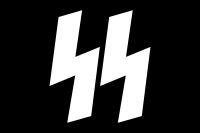Schutzstaffel facts for kids
Quick facts for kids Schutzstaffel (SS) |
|
|---|---|

The double-Sig Rune SS insignia
|
|
| Founded | November 9, 1925 |
| In | Germany |
| Years active | 1925-1945 |
| Territory | Nazi Germany |
| Ethnicity | German |
| Criminal activities | Killed millions of people during The Holocaust |
The Schutzstaffel (SS) was a very large security and military group. It was controlled by the Nazi Party in Germany. The letters "SS" were sometimes written using special runic symbols, like this: ![]() . This symbol was often seen on SS flags and badges.
. This symbol was often seen on SS flags and badges.
The SS played a huge part in The Holocaust. For example, they managed the Nazi concentration camps and death camps. In these camps, they killed millions of people. After World War II, judges at the Nuremberg Trials said the SS was an illegal criminal organization. They also stated that the SS was the main group responsible for the Holocaust.
Contents
What was the SS?
The SS was started in 1925 to guard the Nazi leader Adolf Hitler. The name Schutzstaffel means "Protection Squadron" in German. From 1929 to 1945, Heinrich Himmler was the leader of the SS. Under his leadership, the SS grew from a small group of people who acted like soldiers into one of the biggest and most powerful organizations in Nazi Germany.
The Nazis thought the SS was a very special group, much like the Praetorian Guard that used to protect Roman emperors. To join the SS, a person had to be considered "racially pure" by the Nazis. This meant they had to prove that all their family members were "Aryan". They also had to be completely loyal to the Nazi party. They were not allowed to ask questions or disagree with anything the SS did.
Different Parts of the SS
The SS had two main parts. The Allgemeine-SS ("General SS") acted as the Nazis' police force. The Waffen-SS ("Armed SS") were special groups of soldiers within Nazi Germany's military. The Waffen-SS became known for fighting very fiercely and for being cruel to civilians and prisoners of war.
Its units helped to stop the Warsaw Ghetto Uprising. This was when Polish Jews tried to fight back against the Nazis. Waffen-SS units also killed many American prisoners of war during the Battle of the Bulge in 1944. The SS had its own system of ranks, badges, and uniforms. This made the SS different from the regular German military and the government.
How the SS Gained Power
As the Nazi party became more powerful in Germany, it gave the SS control over more important jobs. This included things like law enforcement. Many SS groups became as powerful as parts of the government itself. The Nazi party decided to give the SS two even more important jobs to help them keep their power.
One of these jobs was to create and run the Sicherheitsdienst (SD). This was the Nazi security and intelligence service. The other job was to control the Geheime Staatspolizei (Gestapo), which was the SS secret police. Because the SS was in charge of so many important things, it could do almost anything it wanted.
The SS and The Holocaust
As the leader of the SS, Heinrich Himmler used the SS to carry out the Final Solution. This was the Nazi plan to murder all Jews. The SS Einsatzgruppen were special groups that murdered many civilians, mostly Jews. They did this in countries controlled by Nazi Germany during World War II.
The SS was also in charge of creating and running concentration camps and death camps. These were camps where people were sent to be killed. In these camps, millions of prisoners died from many causes. These included murder, starvation, disease, and freezing to death.
After World War II
After the war, judges at the Nuremberg Trials decided that the SS was a criminal organization. This meant it was a group created only to commit crimes. They ruled that the SS had committed war crimes and terrible crimes against humanity. The judges also said that the SS was the main group that carried out most of the Holocaust.
Related pages
- The Holocaust
- Nazi concentration camps and death camps
- Holocaust victims
- Einsatzgruppen
- Nazi Germany
- Heinrich Himmler
Images for kids
-
Nazi Party supporters and stormtroopers in Munich during the Beer Hall Putsch, 1923
-
Heinrich Himmler (with glasses, to the left of Adolf Hitler) was an early supporter of the Nazi Party.
-
Himmler inspecting Sturmgeschütz III of the 1st SS Panzer Division Leibstandarte SS Adolf Hitler in Metz, France, September 1940
-
Indian Legion troops of the Waffen-SS guard the Atlantic Wall in Bordeaux, 21 March 1944
-
Grand Mufti of Jerusalem Haj Amin al-Husseini greeting Bosniak SS volunteers before their departure to the Eastern Front, 1943
-
Ernst Kaltenbrunner, Heinrich Himmler, August Eigruber, and other SS officials visit Mauthausen concentration camp, 1941
-
Red Cross passport under the name of "Ricardo Klement" that Adolf Eichmann used to enter Argentina in 1950
See also
 In Spanish: Schutzstaffel para niños
In Spanish: Schutzstaffel para niños














